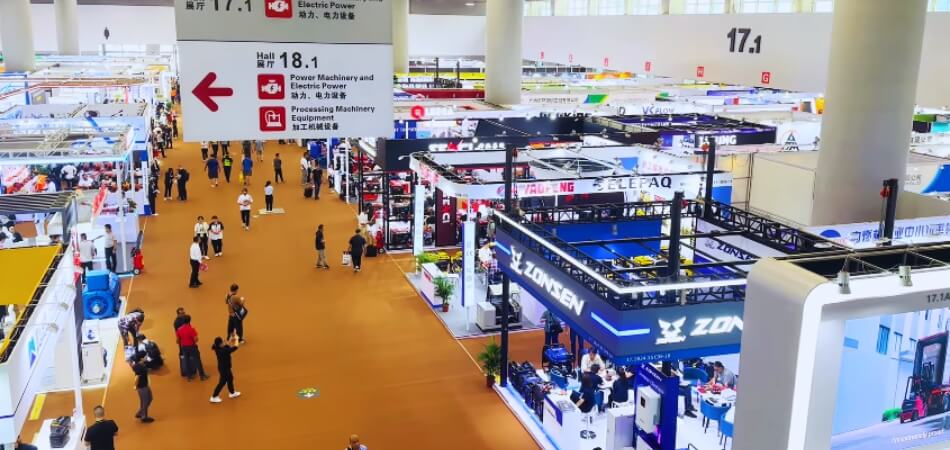Trade fairs are bustling hubs of innovation and opportunity, showcasing a kaleidoscope of products that range from cutting-edge technology to unique handicrafts. But the question arises, “What do you usually do when you are in a trade fair?”
Taking advantage of these events requires a blend of curiosity and strategy. Exhibitors eager to draw attention to their offerings are your go-to sources for insights and connections. It’s essential to seize every chance to engage with them directly, as they’re not just there to showcase their products but to captivate your interest and involvement.
In this blog, we’ll dive into practical strategies to maximize your trade fair experience, ensuring that you leave with not just brochures and samples but also valuable knowledge and networks. Stay tuned as we explore how to make the most of these dynamic events.
What Happens at Trade Fairs?
Trade fairs are vibrant arenas where businesses showcase their latest products and innovations. These events are not just about exhibitions but also about networking and learning. They serve as a melting pot for ideas, trends, and collaborations.

At these bustling venues, companies from various industries display their newest offerings. Attendees wander through stalls, engaging with exhibitors and experiencing products firsthand. This direct interaction fosters business relationships and offers valuable market insights.
Parallel to the exhibition, seminars, and workshops often take place. Experts share insights on market trends, new technologies, and industry challenges. These sessions are crucial for attendees seeking to stay ahead in their fields.
Different Types of Trade Fairs You Can Attend
Exploring the diverse world of trade fairs reveals a spectrum of specialized events catering to varied interests and industries. Each type of fair offers a unique glimpse into specific sectors, from technology to fashion. Understanding these variations helps attendees align their goals with the suitable event.
Consumer Goods Fairs
Consumer goods fairs are bustling marketplaces showcasing products directly to end consumers. These events feature a wide range of items, from electronics to home decor. Visitors can purchase products, making these fairs ideal for trend-spotting and retail therapy. Exhibitors gain direct feedback from their target audience.
Industrial Trade Fairs
Focusing on B2B interactions, industrial trade fairs cater to specific industry sectors. Here, companies display machinery, industrial technologies, and large-scale solutions. Attendees are usually professionals seeking partnerships and suppliers. These fairs are pivotal for networking and industry advancements.
Technology and Innovation Fairs
These fairs are the epicenters of cutting-edge advancements and futuristic ideas. Startups and tech giants alike unveil their latest inventions. Visitors can experience the newest tech trends and gadgets hands-on. Such events are crucial for tech enthusiasts and industry professionals.
Arts and Crafts Fairs
Arts and crafts fairs celebrate creativity and craftsmanship. Artists and artisans display their handmade goods, from paintings to pottery. These fairs are ideal for finding unique, one-of-a-kind items and supporting local artists. They offer a more intimate and personal shopping experience.
Trade fairs offer a diverse range of experiences tailored to different interests and industries. From tech enthusiasts to art lovers, there’s a fair for everyone. Identifying the right type of trade fair can significantly enhance your experience, whether you’re there to learn, network, or explore.
What Do You Usually Do When You are in a Trade Fair?
Attending a trade fair is an immersive experience that can significantly impact your professional growth and business strategies. It offers a unique opportunity to explore, connect, and learn within your industry. Here’s how you can make the most of your time at a trade fair:

Explore Exhibits
- Discover Innovations: Walking through the exhibit halls, you encounter a wide array of products and services. This is an excellent opportunity to see the latest innovations and market trends firsthand.
- Identify Potential Opportunities: By observing what’s on offer, you can identify new business opportunities or areas for expansion in your own company.
- Gauge Market Trends: The variety of exhibits allows you to understand emerging trends and consumer preferences in your industry.
Network with Professionals
- Build Business Relationships: Engaging in conversations with exhibitors and attendees opens doors to potential business partnerships and collaborations.
- Exchange Ideas: These interactions are not just about exchanging business cards but also about sharing ideas and insights relevant to your field.
- Expand Your Professional Network: Networking at trade fairs can lead to long-term professional relationships that are beneficial for career growth.
Attend Seminars and Workshops
- Learn from Experts: Many trade fairs feature seminars and workshops conducted by industry leaders and experts, offering valuable insights and knowledge.
- Stay Updated: These educational sessions keep you informed about the latest developments, technologies, and strategies in your industry.
- Engage in Discussions: Participating in these sessions also allows you to ask questions and engage in discussions with peers and experts.
Collect Business Cards and Brochures
- Build a Resource Pool: Gathering contact information and promotional materials helps in creating a resource pool for future reference and follow-up.
- Stay Organized: Organizing these materials, post-event can aid in developing a strategic approach for business development and networking.
Evaluate Competitors
- Understand Competitor Strategies: Observing competitors’ booths and presentations provides insights into their marketing and sales strategies.
- Benchmark Your Business: Comparing your products and services with competitors can help in identifying areas for improvement and innovation in your own business.
Enjoy Live Demonstrations
- Experience Products Firsthand: Live demos allow you to see the practical application and functionality of products.
- Interactive Learning: These demonstrations are not only informative but also provide an interactive way to learn about new products and technologies.
A trade fair is more than just an exhibition; it’s a comprehensive experience that combines learning, networking, and exploration. By actively participating in different aspects of the fair, you can gain valuable insights, build lasting relationships, and stay ahead in your industry. Make sure to approach each fair with a clear plan to capitalize on these opportunities fully.
How to Organize a To-Do-List for a Trade Fair?
Organizing a to-do list for a trade fair can be an exciting yet challenging task. It’s a process that involves meticulous planning and attention to detail, ensuring that every aspect of the event is carefully considered and addressed. Here’s a step-by-step guide to help you navigate through the preparation phase seamlessly:
Step 1: Establish Your Objectives
Before diving into the specifics, clearly define what you hope to achieve at the trade fair. This could include increasing brand awareness, generating sales, or networking with industry peers. Your objectives will guide all subsequent planning decisions.
Step 2: Budget Planning
Allocate a budget for various expenses such as booth rental, marketing materials, travel, and accommodation. Staying within budget is crucial for a successful event without financial strain.
Step 3: Booth Design and Materials
Design a booth that stands out and attracts visitors. Ensure you have enough promotional materials like brochures and business cards. The design should align with your brand identity and fair objectives.
Step 4: Staffing and Training
Select a team of knowledgeable and enthusiastic staff. Train them on product knowledge, customer interaction, and sales techniques. The right team can make a significant difference in how your brand is perceived.
Step 5: Marketing and Promotion
Develop a marketing plan to promote your presence at the fair. Utilize social media, email campaigns, and industry publications. An effective marketing strategy can increase foot traffic to your booth.
Step 6: Logistics Management
Coordinate the logistics of getting your materials and team to the event. This includes transportation, accommodation, and scheduling. Efficient logistics ensure everything runs smoothly on the day.
Step 7: Networking Plan
Identify key individuals and companies you want to connect with. Plan how you will approach them and what you wish to discuss. Networking can open doors to new opportunities and partnerships.
Step 8: Follow-up Strategy
Plan how you will follow up with leads and contacts post-event. This might include email follow-ups, phone calls, or scheduled meetings. A good follow-up strategy can convert leads into customers.
Preparing for a trade fair requires a well-structured approach, from setting clear objectives to executing a thorough follow-up plan. By following these steps, you can ensure a productive and successful trade fair experience, boosting your brand and fostering valuable business relationships. Remember, thorough preparation is the key to making the most of these opportunities.
Tips to Maximize Your Visit at a Trade Fair
Attending a trade fair can be a transformative experience for professionals and businesses alike. It’s a unique opportunity to gather insights, network, and explore new trends within your industry. To make the most of this event, here are some practical tips:

- Set Clear Goals: Before arriving, define what you aim to achieve. This could be finding new suppliers, learning about industry trends, or networking.
- Plan Your Schedule: Research the event’s program and identify key seminars or booths to visit. Scheduling prevents missing out on important opportunities.
- Bring Business Cards: Always carry enough business cards. They’re essential for networking and creating lasting professional connections.
- Engage Actively: Participate in discussions, ask questions at seminars, and interact at booths. Active engagement leads to more fruitful experiences.
- Take Notes: Jot down key points during seminars and conversations. These notes are invaluable for post-event reflection and follow-up.
- Use Social Media: Share your experiences on social media using the event’s hashtag. This increases your visibility and connects you with other attendees.
- Follow Up Promptly: After the fair, quickly follow up with new contacts. Timely communication keeps the momentum and interest alive.
A well-planned and active approach to your trade fair visit can significantly enhance the benefits you reap. By setting goals, engaging with others, and following up effectively, you can turn your trade fair experience into a cornerstone for future business success. Remember, every interaction and learning opportunity at a trade fair can be a stepping stone towards your professional growth.
Bottom Lines
In summarizing the crucial aspects of making the most out of a trade fair, it’s vital to remember the importance of a well-thought-out approach. From the initial step of asking yourself, “What do you usually do when you are in a trade fair?” to the final stages of follow-up, each action plays a pivotal role. It’s not just about attending; it’s about engaging, exploring, and extracting the utmost value.
Networking with intention, learning from seminars, and observing market trends is essential. The insights and connections gained can have long-lasting impacts on your professional journey.
Thus, navigating a trade fair with a clear strategy and an open mind can turn an ordinary visit into a powerhouse of opportunities, fostering both personal growth and business success.


